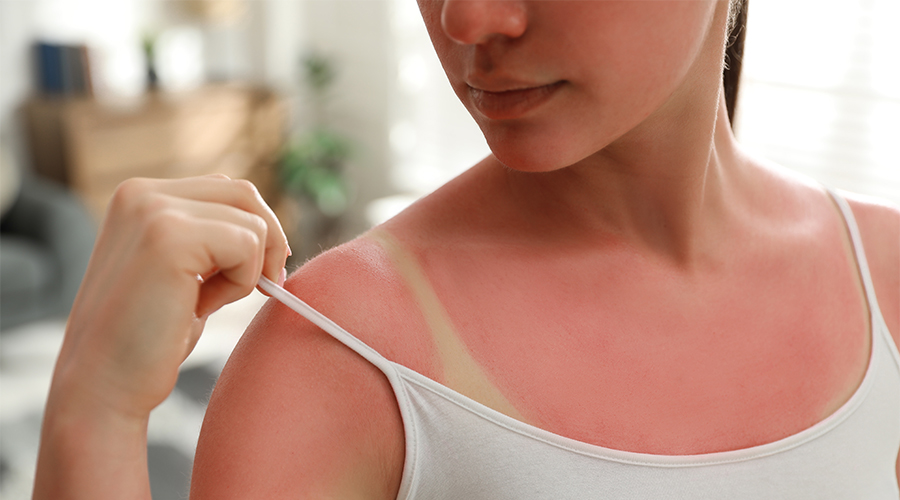

While many people lather on sunscreen and wear sun-protective gears to prevent skin tanning, there are others that deliberately head to tanning beds to flaunt that bronzed complexion. Recent studies have shown that even little tanning can be bad for your skin.
Keep scrolling to understand how sun tan affects your skin and what are the ways to avoid it. Moreover, explore healthier ways to achieve the sun-kissed look.
What Happens When You Tan?
Skin tanning is a direct response to exposure to ultraviolet (UV) rays from the sun or artificial UV lights. Here’s what your skin goes through exposed to UV rays:
- The UV rays trigger a cellular response in the skin which signals the melanocytes to produce melanin (skin pigment).
- Skin color darkens due to the melanin products, acting as protective barriers against further UV damage to deeper skin layers.
The process of skin tanning can’t be reversed. Once your have you’ve tanned, your skin won’t reveal its natural color until the tanned cells shed. This is why it can take weeks until your tan fades, indicating that the sun exposure was seriously high.
Read More: Collagen for Skin: Understand the Secret to Youthful and Radiant Glow
Side Effects of Sun Tan
A study published in the journal Dermatologic Clinics states that any tan at all indicates damage to the skin and therefore. Further the FDA supports that, “There is no such thing as a safe tan.” Immediate and prolonged UV exposure can lead to the following side effects:
Immediate Side Effects of Tanning
- Sunburn: Overexposure to UV rays causes inflammation, redness, and peeling. Severe sun tan increases the risk of long-term skin damage and even scarring.
- Dryness: UV radiation strips moisture from your skin, leaving it dry and potentially leading to wrinkles.
- DNA Damage: UV exposure can cause direct damage to your skin cells’ DNA, which increases the risk of mutations that lead to skin cancer.
Side Effects of Prolonged & Frequent Tanning
- Premature Aging: One of the most immediate signs of overexposure to UV rays is premature aging. This includes wrinkles, age spots, and loss of skin elasticity.
- Skin Cancer: Skin cancer, including melanoma, basal cell carcinoma, and squamous cell carcinoma, is strongly linked to excessive UV exposure. Studies show that tanning beds significantly increase the risk of developing skin cancer, especially in young people.
- Hyperpigmentation: Overexposure to the sun can lead to dark spots or patches, also known as hyperpigmentation. These spots can be difficult to treat and might become more noticeable as you age.
Who’s at Risk?
Everyone is at risk of sun tan and skin damage when exposed to UV rays. However, having a darker skin (containing more melanin) can naturally provide more protection against UV rays due to the presence of more melanin as compared to lighter skin. But that does not mean that people with darker skin are immune to getting sunburnt or sun damage. Therefore, it would be wise to avoid tanning as much as possible. Check the next section to know how.
How to Prevent Skin Tanning?
If you do choose to spend time in the sun, it’s crucial to protect your skin to minimise damage:
- Use Sunscreen: The best SPF for tanning is the one that has the least SPF 30. Use it even on cloudy days, and reapply every two hours or after swimming for better skin care.
- Wear Protective Clothing: Hats, sunglasses, and protective clothing can help shield your skin from UV exposure and prevent skin tanning.
- Seek Shade: Try to stay in the shade during peak sun hours (10 a.m. to 4 p.m.) when UV rays are strongest.
- Avoid Tanning Beds: The safest way to protect your skin from sun tan is to avoid tanning beds (sunbeds) altogether, as they are a major source of harmful UV exposure.
While some body tanning beds claim to be “safer” by using UVB rays, they can still lead to long-term skin damage. In fact, the World Health Organization (WHO) has classified tanning beds as a Group 1 carcinogen, meaning they are known to cause cancer.
Simple Tips to Reduce Sun Tan
Here are some of the best tan remover tips:
- Exfoliate: Use a gentle scrub, sugar scrub, or loofah to remove dead skin cells and fade the tan.
- Lemon Juice: Apply lemon juice to lighten skin due to its natural bleaching properties.
- Aloe Vera: Use aloe vera gel to soothe skin and help lighten the tan.
- Moisturize: Keep skin hydrated to prevent dryness and help even out the sun tan.
- Best Tan Remover Products: Use over-the-counter tan-removal lotions or creams.
- Professional Treatments: Consider chemical peels or treatments from a dermatologist for faster results.
The Safe Way to Get a Tan
If you still love the look of a body tan but want to avoid the risks associated with UV exposure, there are safer alternatives available:
- Self-Tanners: Self-tanning lotions and sprays are an excellent alternative to sunbathing or tanning beds. They contain ingredients like DHA (dihydroxyacetone), which react with the skin’s amino acids to create a temporary tan without any UV exposure.
- Bronzers: Bronzing powders and creams can give your skin an immediate tan-like effect and can be easily washed off at the end of the day.
- Tanning Mists: Tanning mists or sprays are also a popular option for those seeking a quick, streak-free tan that doesn’t involve harmful UV rays.
Closing Thoughts
Skin tanning is common but when excessive exposure to UV rays can damage the skin leading to wrinkles, sunburns, peeling, or even cancer. Fortunately, there are plenty of ways to achieve a sun-kissed look without putting your skin at risk. When out in the sun, always use sunscreen, consider self-tanning products, and protect your skin from excessive exposure. Opt for spray tanners over tanning beds to avoid exposure to UV rays.




